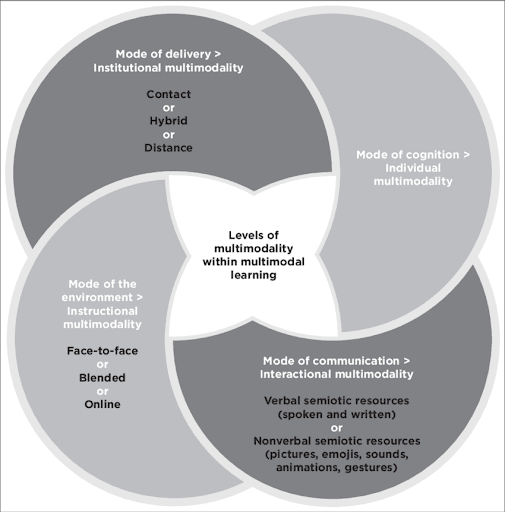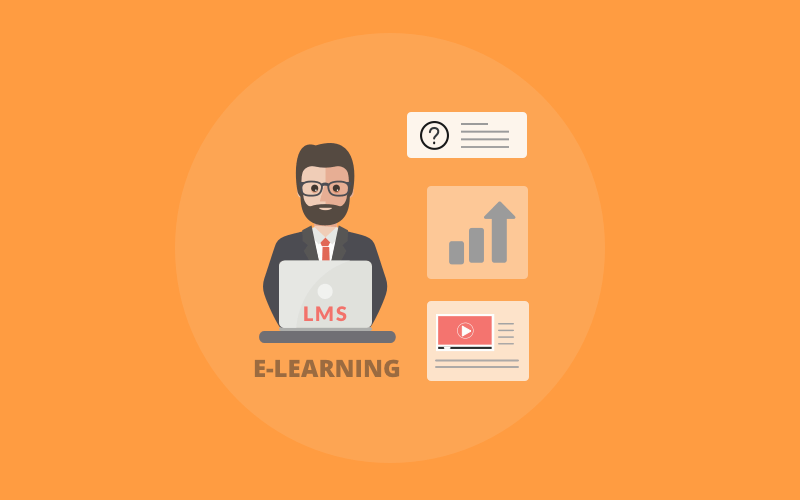
Every human brain processes information differently. A 2018 study by the University of Zurich shows that, like fingerprints, every human brain has a unique anatomy. This uniqueness is due to different genetic coding and individual life experiences.
So, if every person receives, stores, and processes information in a different way, how can you use the same learning approach to teach your whole class or team?
The solution lies in multimodal learning that makes the same information easily processable for your entire team.
But what is multimodal learning?
Don’t scratch your head! Just scroll down to understand what multimodal learning is, examples, its benefits, types, strategies, and more.
What is Multimodal Learning?
Multimodal learning can be defined as teaching using multiple modes (channels of information). It denotes a combination of visual, auditory, and kinesthetic senses in delivering learning for better understanding by learners.
Suppose you are organizing an onboarding program for marketing executives in your company to launch an account-based marketing or ABM campaign. In this case, the multimodal training will take the following form:
First, provide text-based documents on ABM and basic customer information
↓
Enroll candidates into webinars to explain the sales funnel and audience segmentation process
↓
Then, you can request the learners to provide an ABM campaign demo model
↓
Finally, you provide one-on-one feedback to your new marketing employee to communicate their strengths and weaknesses
To make this possible, instructors can use eLearning authoring tools to create and deliver audio, visual, and 3D training to their learners.
Four Main Types of Multimodal Teaching
Multimodal learning techniques revolve around human senses. Thus, there are four main types of multimodal learning based on the VARK learning style that you should target. They are:

1. Visual Learning
Visual learning encompasses anything that can invoke visual senses among learners, such as graphics, photos, infographics, videos, and more.
There are many great visual tools you can use to produce interactive learning materials. You can create interactive picture puzzles and games to increase learners’ knowledge acquisition and retention.
2. Auditory Learning
Auditory learning style targets learners with excellent listening abilities. This mode of learning is useful in providing online employee training, as individuals can listen to audio lessons while driving or doing other tasks.
Almost 30% of the population today are audio learners. Thus, you can use resources such as podcasts, webinars, audiobooks, and group discussions to create your audio multimodal learning material.
3. Kinesthetic Learning
Kinesthetic learning is an active learning model. Multiple learning modes such as live demonstrations, site visits, and multimedia presentations are merged in this technique.
This multimodal learning environment stimulates different senses for each learner and thus helps to keep them engaged and motivated.
Watch: The Kinesthetic Classroom: Teaching and Learning through Movement
4. Reading and Writing
Reading and writing is the more traditional method of learning. It is simple text-based learning model that you can use to train your employees, customers, and other stakeholders. You can create PDFs, blogs, and whitepapers in this approach and share them via email or as a part of an eLearning course.
Benefits of Multimodal Learning in the Modern Workplace
Multimodal learning is in a way akin to personalized learning, whereby learners get a chance to learn from the modes that their brain processes better and faster.
According to a Cisco study, learners who learn via a combination of visual and text material learn better than those who learn through a text-only method.
So, the right blend of educational and training materials can create a dynamic learning environment in your organization. This can ultimately improve your team’s productivity.
Instructors and learners can enjoy several benefits from multimodal learning, such as:

1. Engaging a Whole Team
If you have a large team, multimodal learning will help you stimulate each member’s learning ability by catering to their unique needs. With multimodal learning, you can develop a comprehensive learning environment that can be understood and processed by everyone in your team.
2. Improved Retention Rates
One type of learning model can become boring after a point. Therefore, when you incorporate different learning environments in your training program, it improves the retention rate of learners and keeps them engaged with your learning material.
3. Ability to Solve Real-World Problems
When you provide only theoretical knowledge to your employees, they will not be able to use that information to solve real-world problems. However, using multiple model learning systems, you can adopt text-based, live demos, and many other tools to teach your employees how to apply their knowledge in real-life situations in a practical manner.
For example, simply asking your employees to read blogs about Making Tax Digital (MTD) will only tell them what MTD actually is. But, if you want your employees to learn how to use MTD software in a real sense, you have to provide them with a proper MTD platform to test their knowledge.
4. Promoting Creativity
Multimodal learning adds creativity to your learning structure. Training administrators can use virtual classroom software and a real-time collaboration tool to motivate participants to engage in social learning and use their creativity to solve daily learning challenges.
5. Self-Paced Learning
When instructors create learning material based on individual learning and cognitive abilities, it helps the latter learn at their own pace.
For example, providing video lectures instead of regular classroom lectures lets learners play, pause, and resume lessons multiple times and learn at their own pace.
Easy Ways to Incorporate Multimodal Learning
It might seem like implementing a multimodal learning system creates an additional amount of work for the person/organization who is organizing the training. However, when you use the right online learning tools, technology, and approach, it will be very easy to implement multimodal learning in your organization.
Below you will find some useful tips to help you with this:

1. Focus on Visual Arts
Visual learning is one of the important multimodal learning techniques. You can create different visual learning art such as diagrams, infographics, charts, and graphs, to train your learners.
The best multimodal learning strategy here is combining visual and text-based learning materials. For example, you can write a paragraph on a topic and create a diagram or visual presentation to explain the concept further. This way, you can help both visual and text learners.
2. Use Blended Learning Approach
Blended learning is an innovative way to communicate with different types of learners. In this approach, you need to create different types of learning materials such as games, podcasts, blogs, and more.
Blended learning might sound like a lot of work. But, once you have the right tools, you can easily implement a blended learning strategy in your organization.
3. Talk to Your Team
Instead of experimenting with different learning models, you could simply have a one-on-one conversation with your team members to understand which learning modal they prefer the most.
This approach will potentially eliminate all the additional work required to build a multimodal learning strategy for your team. On the other hand, it will set responsibility for learners to perform better as they have themselves selected their preferred learning model.
You can also help them self-assess their learning style with a help of a quick quiz like this:

Examples of Multimodal Learning
Now that you know what multimodal learning is and how to incorporate it in your organization let’s check out a couple of multimodal learning examples.
1. Games
Educational and brain-teasing games are the best way to incorporate multimedia learning in your organization. There are different types of learning games available online that you can use to train your employees, such as MentalUP, Tangram, etc.
2. Group Projects
Group projects are useful to teach your team members how to work in a collaborative environment. They will learn how to use the strengths of individual team members to complete a project. It is a great multimodal learning and team-building strategy.
3. Case Studies
Based on real-life scenarios, case studies help learners relate classroom learning to real examples. You can assign different assessments to evaluate their understanding of cases. When your learners realize that what they are learning has meaningful connections with the real world, it motivates them to learn more.
How to Customize Multimodal Learning Approach
Multimodal learning is a highly effective way to teach new things to your team. However, you can make your multimodal learning more effective by creating a custom strategy based on your teammates’ strengths and weaknesses.
Here’s how you can customize a multi-model learning strategy:
1. Use Different Content Styles
By using different content styles, you can strengthen your multimodal learning approach. You can use audio, short videos, infographics, presentations, and other eLearning material to build a custom multimodal learning environment for your corporate training.
Pro tip: Don’t go overboard as it will only overwhelm your learners in the end. For example, if you want to show your team how to use an automatic tool, first provide a manual to your team members. After that, provide them practical training and finally, ask them to take a test to gauge their comprehension.
2. Use Digital Learning Tools
Online learning is the mainstream learning system today. From schools to enterprises, everyone is using different online learning tools to create, manage, and measure learning & development.
Digital learning enables instructors to target different modules of multimodal learning. You can create interactive video lessons and upload them on YouTube so your learners can watch them anytime and anywhere. Doing this helps audio and visual learners to understand different concepts at their own pace.
Similarly, you can publish podcasts, blogs, and other learning resources on your website to provide information to your employees or customers.

Nowadays, many learner-centric software applications such as a learning management system are also available. They can help you create, share, and track interesting online courses and tests with anyone, anywhere, anytime. Some of these solutions are highly configurable to meet the specific needs of end-users.
3. Get Feedback From Learners
This is a very important factor in creating a multimodal learning environment in your workplace. Feedback helps you understand how much your learners have actually learned from your different learning approaches.
It will help you understand which learning method has been more successful for your team. This way, you can invest more resources in the more successful learning model instead of experimenting with different learning systems.
You can use engaging online surveys with different question types and formats to gather feedback from your learners on your learning programs.
Dynamic Multimodal Learning Strategies You Must Try in 2024
Multimodal learning is a perfect solution for improving the quality of instruction and learning, no matter which department you’re training. However, you have to use the right multimodal learning strategies to derive the desired results.
Based on different learning modules, here are a couple of strategies that you can use in 2024:
1. Multimodal Learning Strategies for Auditory Learners
- Organize guest speeches and lectures in your organization
- Create songs or podcasts
- Host group discussions
- Allow your employees to present their ideas during meetings
- Host seminars
2. Multimodal Learning Strategies for Visual Learners
- Use symbols and illustrations to highlight important points
- Create infographics, art pictures, and other illustrations
- Share online videos and webinars
- Teach via flowcharts, slide shows, diagrams, & graphs
- Assign color codes and highlight important parts using different forms
3. Multimodal Learning Strategies for Kinesthetic Learners
- Live site visits
- Experiments with different learning resources
- Use real-life examples & case studies
- Provide multimedia presentations
- Group projects, prompt quizzes, and surveys
4. Multimodal Learning Strategies for Reading/Writing Learners
- Write an essay on a current topic
- Include multiple-choice, short answer, and essay questions
- Note down important points during the class
- Share a class experience in your own words
- Read different books and blogs related to your topic
Start Investing in Multimodal Learning!
No two learners learn the same way. So, whether you want to teach senior employees or a 10-year-old child, multimodal learning is the best approach to take. It is learner-friendly as it relies on a mode of learning that caters to individual preferences.
When learners get to learn just the way they want, they become fully engaged and motivated. This, in turn, leads to better information retention, performance, and productivity.
If you’re yet to embrace a multimodal learning system, it’s high time you give it a thought. One of the easiest ways is to adopt the best LMS software that supports multimedia files or eLearning material in different formats. You can easily import your existing content and get a program up and running in no time.
FREE. All Features. FOREVER!
Try our Forever FREE account with all premium features!







